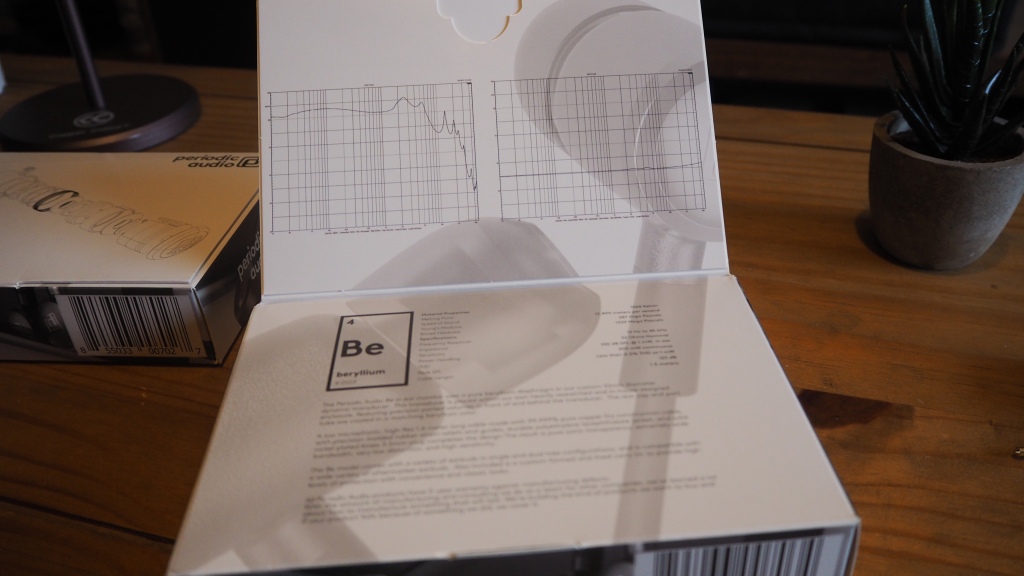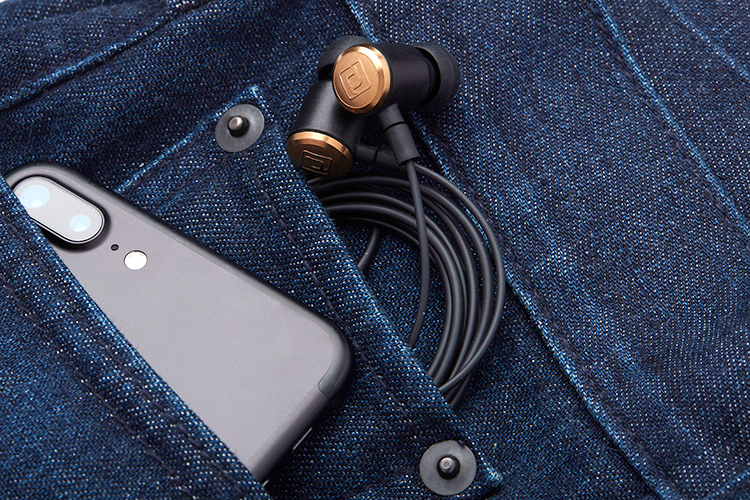
Disclaimer:
Periodic Audio have not paid or sponsored me for this review.
The views and opinions in this piece are unbiased and my own.
Dan and the team at Periodic were kind enough to send me out three review samples and the Be’s are the second out of three reviews.
They are priced at $299 as of this publication.
https://periodicaudio.com/

Review equipment and software used:
Samsung Galaxy Note Ten+.
Audioquest Dragonfly Black V1.5.
Qobuz Studio.
Packaging and accessories:
These are the second pair of iem’s I have tried out from Periodic Audio and the thing that stood out immediately was the theme around their product and packaging. The name Periodic Audio is a play on words and is a nod to the periodic table. As you will learn with Periodic Audio’s products, they’re all named in relation to the materials used. I think this is a brilliant approach.
The boxes themselves when opened up display a graph. We all know by now at The Audiophile Cafe that I don’t do measurements. However I do appreciate this touch and this will be something other reviewers or customers will no doubt enjoy.
The IEM’s themselves come securely packaged in the cardboard cutout alongside a smart round tin that can be easily pocketed.
Inside said tin are the accessories which include a flight adaptor, a generous selection of ear tips including some high quality foam tips and a 1/4 inch stereo adaptor.


Spec:
Mechanical Elements
Transducer Diaphragm: Beryllium
Transducer Surround: Bonded PEEK
Transducer Basket: Aluminum
Transducer Magnet: N48H Grade Neodymium
Enclosure Body: Polycarbonate
Protective Grille: 316 Stainless Steel
Bonding Compound: Cyanoacrylate Adhesive
Sealant Compound: Polyvinyl Acetate
Mounting Tips: Medical Grade Silicone and Urethanes
All components are finite element analyzed for stress, strain, and durability.
Frequency Response – 12 Hz to 45 kHz.
Impedance – 32 Ohms nominal.
Sensitivity – 100 dB SPL at 1mW in ear.
Power Handling – 200 mW continuous.
Peak – SPL123 dB.
THD – Less than 1% THD at 1mW.
PHYSICAL PROPERTIES:
Cable Length – 1.5 m.
Mass – 2.8 / 9.3 g (IEM/Set).
Operational Temperature – -20 to +50°C.
Operational Humidity – 0-95% Relative Humidity.
NRR – 31.3 dB (foam eartrip).
Overall Length – 21 mm.
Body Diameter – 12 mm.
Nozzle Diameter – 6 mm.
MATERIAL PROPERTIES:
Melting Point – 1560 Kelvin.
Speed of Sound – 12890 meters per second.
Young’s Modulus – 287 Gigapascals.
Brinell Hardness – 1320 Megapascals.
Build:
As I stated in my first review of the Periodic Audio Ti’s, the brand is fast becoming a favourite of mine when it comes to design, style, quality, sound and comfort. The Be’s may only be my second pair from Periodic Audio but they are a deal closer. Two Similar yet very different IEM’s built to the highest quality. They are simply a nod to some of the finest craftsmanship I’ve come across in my time as an audiophile and reviewer.
Unlike the Ti’s the Be’s have Beryllium transducer diaphragms. And it shows. But we’ll get into that in a moment.
The cable again is something I would like to see being looked at in following models. But I won’t get into that again as I have mentioned this in a previous review.


Comfort:
The Berylliums are a very comfortable pair of in ears.
They are lightweight and a good fit. The foam tips supplied have an excellent seal and grip my ears with no discomfort.
I could wear these for up to two hours with no pain or fatigue.
I will note here that although they won’t offer as good a seal as the foam tips, the silicone tips are comfier and allow me to listen for a touch longer.
Soundstage & Imaging:
Here’s where the Berylliums show their vast difference to the Titaniums that I previously reviewed.
A wider soundstage with a depth that surprised me. The Be’s put me in the middle of a large arena or stadium with ease. I found the foam tips narrowed the soundstage a touch but not by any great margin.
Instrument separation is excellent.
Bass:
I won’t lie, I was expecting the bass to be far less present in the Berylliums in comparison to the Titaniums. However, taking a peek at the spec sheet had me anticipating something interesting. The Ti’s are capable of 16hz on paper where the Be’s are capable of 12hz…
The Berylliums go lower yet without the force of the Ti’s.
It’s a more refined tight bass with far more accuracy but still managing to hit hard when required and go deeper than you expect them to.
Mids:
A smooth airy midrange with ultra fine clarity making the Berylliums really REALLY good with vocals, sax, cello…
It’s not harsh or overwhelming, more a forward, perfectly tuned midrange that sounds oh so good.
Highs:
Fast, accurate highs that bring out all those little details that a lot of in ears struggle to reproduce. At times I felt like I was sat right next to the drummer and could hear even the softest of brush strokes.
In a word, breathtaking.

Summery and recommendations:
The Berylliums get The Audiophile Cafe 5 star award for their astounding level of clarity and comfort with premium craftsmanship and a fantastic design.
Where the Titaniums brought me that hard hitting punch that brought my electronic music alive, The Berylliums make jazz, classical, folk and Spanish guitar an utter pleasure to listen to with clarity, depth and sparkle that captures you.
Precision and premium are the keywords of the day here.
Worth every dollar of their $299 price tag.
All my thanks and best wishes to all of my readers.
Please don’t forget to leave any thoughts in the comments.
If you would like to join the facebook group I’ll leave a link just below.
https://www.facebook.com/groups/516367948761119/?ref=share
The Audiophile Cafe is sponsored by a small group of brands. Helping me to gradually bring better content to you.
Thank you to Airpulse for their ongoing support and sponsorship.

